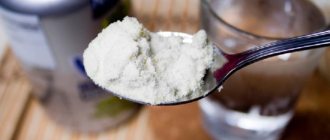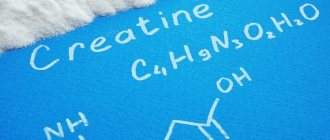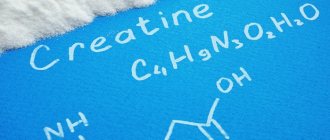© ayo888 — depositphotos.com
Share:
Creatine is considered the safest sports nutrition supplement. A lot of positive qualities and effects are attributed to this compound. However, under certain circumstances, creatine can still cause harm to health.
Before you start taking the drug, you should understand what creatine is and learn about its contraindications and side effects.
Discovery of Creatine
Creatine was first isolated in the first half of the 19th century, and at the beginning of the next century, scientific experiments were conducted proving that regular use of the substance increases muscle strength. At the same time, “phosphocreatine” was discovered - combined molecules of creatine and phosphate, which, when accumulated in the body, improve metabolism. The most effective form of creatine was recognized as its monohydrate - paired molecules of creatine and water.
The victorious march of creatine in sports began in 1992 after the publication of a study by Swedish doctor Eric Haltman. He has proven that taking 20 grams of creatine monohydrate daily increases muscle creatine content by 20%. A year later, an authoritative publication on sports medicine published an article about the effective use of creatine by Swedish athletes. Later studies showed that for results you do not need to take 20 grams of creatine, but 5-7 grams per day is enough. But the effectiveness of creatine has always been confirmed.
Since that time, creatine monohydrate has become a popular dietary supplement among athletes around the world. Creatine is not included in the list of prohibited doping substances, which means it can be used in any competition.
We recommend reading: What is protein and what is it for?
It is important to remember that creatine is not an essential supplement - it is produced in the body from amino acids (glycine, methionine, arginine), so there is no need to necessarily get your creatine intake from dietary supplements. In sports nutrition, creatine is obtained chemically in laboratories, but there is nothing wrong with that. The process that occurs in the body is reproduced in the laboratory and the same creatine is obtained, no less natural.
Biological role of creatine[edit | edit code]
Creatine is a natural substance found in human and animal muscles and is required for energy metabolism and movement. The human body contains about 100-140 g of this substance, which acts as a source of energy for muscles. The daily consumption of creatine under normal conditions is approximately 2 g. Creatine is as important for life as protein, carbohydrates, fats, vitamins and minerals. Creatine can be synthesized by the body independently from 3 amino acids: glycine, arginine and methionine. These amino acids are components of protein.
In humans, the enzymes involved in creatine synthesis are localized in the liver, pancreas and kidneys. Creatine can be produced in any of these organs, and then transported by the blood to the muscles. Approximately 95% of the total creatine pool is stored in skeletal muscle tissue.
As physical activity increases, creatine consumption also increases, and its supply must be replenished through diet or through the body's own natural production.
The decisive factor for achieving high results in sports is the body's ability to release large amounts of energy in a short period of time. In principle, our body constantly receives energy by breaking down carbohydrates and fat.
The immediate source of energy for skeletal muscle contraction is a molecule called ATP (adenosine triphosphate). The amount of ATP immediately available is limited and is decisive for athletic activity.
All fuel sources—carbohydrates, fats, and protein—are first converted through various chemical reactions into ATP, which then becomes available as the only molecule the body uses for energy. When ATP releases energy to power muscle contractions, the phosphate group is broken off and a new molecule called ADP (adenosine diphosphate) is formed. This reaction is reversed by creatine phosphate, an energy-rich substance.
Creatine combines with phosphate in the body to form phosphocreatine, which is a determinant of energy production in muscle tissue.
What is creatine for?
When performing any movement, energy is consumed; it comes from ATP (Adenosine triphosphate) - a universal source of energy in the body. ATP in cells is always approximately the same amount; it cannot be increased, but it is possible to quickly restore costs. Creatine performs this function and helps maintain ATP levels. Thanks to creatine, strength endurance and the effectiveness of strength training increase.
For athletes
Creatine helps to withstand short loads at maximum intensity, so it is necessary for sprinters and strength athletes. Effective in combat and game sports with frequent accelerations: football, basketball, hockey, etc.
In endurance sports (such as long-distance running), creatine has little effect - it does not increase overall endurance. Supplementation of creatine by endurance athletes is justified if they need to increase muscle strength. During training camps with a lot of strength training, creatine will have a positive effect.
Vegetarians
Meat is the main source of natural creatine, and its lack is harmful to health. Therefore, vegetarians are advised to take small doses of creatine to maintain health.
In medicine
Creatine is used in medicine for the rehabilitation of patients who have been immobile for a long time.
Conclusion
Creatine can help you achieve any goal you set for yourself in the gym. From increasing strength in many exercises to supporting recovery. Creatine can also help in any sport that requires speed, bursting, and faster recovery between workouts. Vegetarians may see much greater benefit from taking it because they have much less creatine due to the lack of meat and fish in their diet. With very few side effects, creatine can be a great booster for faster muscle growth and maximize strength and performance in a cheap and fast way.
Benefits of creatine
- Increases strength endurance
Muscles can work on creatine phosphate synthesis for 6-15 seconds. By increasing creatine reserves in the muscles, the duration of explosive work increases by 20-30%.
When switching from creatine-phosphate energy supply to glycolysis, acidification begins. But here creatine helps out too - it delays the moment of acidification to 1 - 1.5 minutes.
- Increases muscle mass and strength
The increase in muscle mass and strength occurs indirectly due to an increase in performance. Creatine helps you work out longer, so your muscles grow faster. It is important not to confuse swelling with muscle gain. Creatine retains water and increases cell size. The muscle becomes “inflated”.
Important! The effect of creatine, like any other sports nutrition, corresponds to the load. When working on mass in the gym, it will help you gain mass. Creatine will not make a skier, track and field athlete, cyclist, or swimmer “jump,” but it will speed up recovery and increase muscle power.
- Improves muscle definition
Taking the drug allows you to improve muscle definition. This is due to both increased endurance during training and water retention - the greater the supply of creatine in the muscles, the more water it contains and the larger it looks.
- Serves as a lactic acid buffer
The familiar burning sensation after training serves as a signal that lactic acid has accumulated in the muscles. Creatine can inhibit the release of lactic acid and reduce recovery time after exercise.
- Protects the cardiovascular system
Helps restore the heart muscle after a heart attack, with arrhythmia and ischemia. Promotes vascular restoration. Protects the heart muscle when working in conditions of lack of oxygen.
- Protects the central nervous system
Helps the development of the brain and the entire nervous system. Improves the conduction function of the nervous system and the contractile function of muscles, including the heart.
- Normalizes blood cholesterol levels
We recommend reading: Why do we need bcaa and how to take it?
Effect of use
The main function of the product is to increase endurance. With longer and more intense workouts, the weight loss process goes faster, and the results last a long time. The drug helps muscles recover faster, taking adipose tissue as the main source of energy.
Proper training involves not only a large number of approaches and a gradual increase in loads, but also the correct technique for performing the exercises. Rapid depletion of energy reserves makes it impossible to perform each subsequent approach correctly, which can lead to injury and not provide any effect from the load.
Increasing endurance does not only apply to one sport; this effect also manifests itself during fitness classes. Muscle growth occurs with any regular exercise.
The monohydrate substance is deposited in the tissue and attracts a large amount of liquid, which helps the fibers become more rounded and prominent. This effect is clearly visible when working on abdominal tone.
There is an opinion that monohydrate helps to gain muscle mass, but this is not true. It helps increase strength loads, which lead to increases. But without proper nutrition containing a large amount of protein, gain cannot occur.
Which creatine is best?
Creatine monohydrate powder is more profitable and of higher quality. Creatine powder is almost always cheaper than capsules and tablets. In addition, it is better absorbed. most effective supplement . The most studied form of creatine - all the effects and recommendations are associated with it. The remaining forms of creatine are creatine monohydrate + something else. Many brands are trying to invent their own type of creatine and present it as a scientific breakthrough. This is nothing more than marketing. None of these forms showed better effectiveness compared to the monohydrate.
We prefer well-known and proven brands:
- Optimum Nutrition
- Universal Nutrition
- NOW
- muscletech
- MyProtein
There are other good brands, but these are the ones we trust. By the way, it is at the top of most world sports nutrition ratings.
Video
How to take creatine monohydrate. Effect, side effects, reviews "
HOW DOES CREATINE MONOHYDRATE WORK? Papa Smith's Practice
Why do you need Creatine Monohydrate? Papa Smith Supplements
How to take creatine powder?
Methods of taking creatine are the same for all forms: tablets, capsules, powders. The main thing is to take the right dosage.
There are two main ways to take creatine
- With loading and maintenance phases. The loading phase lasts 3-7 days. During the first phase, you need to take 0.2-0.3 grams of creatine per 1 kg of body weight - about 20-25 grams per day. The maintenance regimen lasts 20-25 days. During this period, you need to take 2 grams of creatine per day.
- The usual method without downloading. 3-7 grams of creatine every day during the course. It is optimal to divide the dose into the number of meals per day. For example, 1 gram 4 times a day.
We recommend using the second method and taking monohydrate daily in equal portions . This will reduce the risk of side effects and save you money. Also, in some studies there is information that the body absorbs no more than 5-7 grams of creatine per day, the rest will be excreted by the liver and kidneys.
How long should I take creatine?
At the moment, there are no studies on long-term use of creatine, so it is better to take it in courses of 1 month. After this, take a 1 month break.
Dosage
Many experts claim that taking creatine in a dosage of less than 5 g per day will not lead to any results (or they will be insignificant). At the same time, there are studies that prove that a dosage of more than 15 g per day also does not lead to anything good (the results do not get better).
This is due to the fact that human muscle tissue stores creatine in strictly limited quantities. Muscles can absorb it in limited quantities, so it does not matter how much a person takes during the day.
In this case, taking a properly selected amount of creatine will be completely related to the athlete’s weight. For athletes of small and medium weight, the optimal daily dosage of creatine is 5-10 g. For those weighing more than 90 kg - 10-15 g per day.
When to take creatine?
There is no need to take creatine before training - the substance causes dehydration and disrupts the water-salt balance. There is also no point in taking creatine between exercises.
Creatine intake is not tied to training in any way, so simply take it before or after meals. Creatine is better absorbed with something sweet, so it is better to drink monohydrate with juice, protein or gainer. It is important that at least a glass of liquid enters the body with creatine.
We recommend reading: What is melatonin for and should you take it?
Use of the drug
Bodybuilders use creatine to build muscle mass. The accumulated substance is used by the body to improve performance in those sports that involve the use of peak force in short periods of time. The use of the drug is recommended:
- when performing intense training exercises;
- when running short distances;
- in cycling sprint;
- in weightlifting;
- when jumping;
- hockey players, football players, tennis players;
- vegetarians
Side effects of creatine
Do not take creatine in large doses! It creates increased stress on the liver, kidneys, stomach and intestines. All side effects in healthy people appear after repeatedly exceeding the dose of creatine.
- Fluid retention in the body
People with a tendency to edema should not take creatine, because it disrupts water-salt metabolism. Healthy people need to drink a lot of water while taking creatine to avoid dehydration - the muscles take up water and the body lacks fluid.
- Stomach disorders
Digestive disorders may occur due to water-salt imbalance. Excess creatine will not be absorbed in the intestines and will draw water onto itself, resulting in diarrhea. The reason is not the quality of creatine, as many people are beginning to think, but its excess.
- Toxic effects on the liver and kidneys
Excess creatine remains circulating in the blood, passes through the liver and kidneys, placing stress on them. Doses of 20 grams or more of creatine per day can cause potential harm. For those with liver and kidney problems, it is better to avoid taking additional creatine and get it only from food. Taking additional can help your body produce its own creatine.











